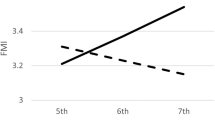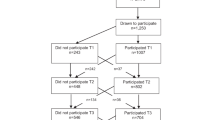Abstract
OBJECTIVE: This study examined the relation among children's physical activity, sedentary behaviours, and body mass index (BMI), while controlling for sex, family structure, and socioeconomic status.
DESIGN: Epidemiological study examining the relations among physical activity participation, sedentary behaviour (video game use and television (TV)/video watching), and BMI on a nationally representative sample of Canadian children.
SUBJECTS: A representative sample of Canadian children aged 7–11 (N=7216) from the 1994 National Longitudinal Survey of Children and Youth was used in the analysis.
MEASUREMENTS: Physical activity and sport participation, sedentary behaviour (video game use and TV/video watching), and BMI measured by parental report.
RESULTS: Both organized and unorganized sport and physical activity are negatively associated with being overweight (10–24% reduced risk) or obese (23–43% reduced risk), while TV watching and video game use are risk factors for being overweight (17–44% increased risk) or obese (10–61% increased risk). Physical activity and sedentary behaviour partially account for the association of high socioeconomic status and two-parent family structure with the likelihood of being overweight or obese.
CONCLUSION: This study provides evidence supporting the link between physical inactivity and obesity of Canadian children.
This is a preview of subscription content, access via your institution
Access options
Subscribe to this journal
Receive 12 print issues and online access
$259.00 per year
only $21.58 per issue
Buy this article
- Purchase on Springer Link
- Instant access to full article PDF
Prices may be subject to local taxes which are calculated during checkout
Similar content being viewed by others
References
World Health Organization. Obesity: preventing and managing the global epidemic. Report of a WHO Consultation on Obesity. World Health Organization: Geneva; 1998.
Tremblay MS, Willms JD . Secular trends in the body mass index of Canadian children. Can Med Assoc J 2000; 163: 1429–1433; 2001; 164: 970.
Tremblay MS, Katzmarzyk PT, Willms JD . Temporal trends in overweight and obesity in Canada, 1981–1996. Int J Obes Relat Metab Disord 2002; 26:538–543.
Willms JD, Tremblay MS, Katzmarzyk PT . Geographic and demographic variation in the obesity of Canadian children. Obes Res 2003; 11: 668–673.
Stephens T, Craig CL . The well-being of canadians: highlights of the 1988 Caompbell's survey. Canadian Fitness and Lifestyle Research Institute: Ottawa, ON; 1990.
U.S. Department of Health and Human Services. Physical activity and health: a report of the surgeon general. U.S. Department of Health and Human Services, Centers for Disease Control and Prevention, National Center for Chronic Disease Prevention and Health Promotion: Atlanta, GA; 1996.
Robinson TN, Killen JD . Ethnic and gender differences in the relationships between television viewing and obesity, physical activity, and dietary fat intake. J Health Educ 1995; 26(2 Suppl): S91–S98.
Gortmaker SL, Must A, Sobol AM, Peterson K, Colditz GA, Dietz WH . Television viewing as a cause of increasing obesity among children in the United States, 1986–1990. Arch Pediatr Adolesc Med 1996; 150: 356–362.
Statistics Canada and Human Resources Development Canada. National longitudinal survey of children: overview of survey instruments for 1994–1995, data collection 1. Statistics Canada Catalogue No. 95-02. Minister of Industry: Ottawa, ON; 1995.
Cole TJ, Bellizzi MC, Flegal KM, Dietz WH . Establishing a standard definition for child overweight and obesity worldwide: international survey. BMJ 2000; 320: 1–6.
Willms JD, Shields M . A measure of socioeconomic status for the National Longitudinal Study of Children. Report prepared for Statistics Canada;1996.
Kraemer HC, Stice E, Kazdin A, Offord D, Kupfer D . How do risk factors work together? Mediators, moderators, and independent, overlapping, and proxy risk factors. Am J Psychiatr 2001; 158: 848–856.
Andersen RE, Crespo CJ, Bartlett SJ, Cheskin LJ, Pratt M . Relationship of physical activity and television watching with body weight and level of fatness among children. JAMA 1998; 279: 938–942.
Hernandez B, Gortmaker SL, Colditz GA, Peterson KE, Laird NM, Parra-Caberra S . Association of obesity with physical activity, television programs and other forms of video viewing among children in Mexico City. Int J Obes Relat Metab Disord 1999; 23: 845–854.
Guillaume M, Lapidus L, Bjorntorp P, Lambert A . Physical activity, obesity, and cardiovascular risk factors in children. The Belgian Luxembourg Child Study II. Obes Res 1997; 5: 549–556.
Crespo CJ, Smit E, Troiano RP, Bartlett SJ, Macera CA, Andersen RE . Television watching, energy intake, and obesity in US children. Arch Pediatr Adolesc Med 2001; 155: 360–365.
Janz KF, Mahoney LT . Maturation gender, and video game playing are related to physical activity intensity in adolescents: the Muscatine Study. Pediatr Exerc Sci 1997; 9: 353–363.
Robinson TN . Reducing television viewing to prevent obesity: a randomized controlled trial. JAMA 1999; 282: 1561–1567.
Statistics Canada. Canada year book, 2001. Catalogue No. 11-402-XPE. Minister of Industry: Ottawa, ON; 2001.
World Health Organization. Health and health bahaviour among young people. WHO Policy Series: Health Policy for Children and Adolescents Issue 1: International Report. World Health Organization: Geneva; 2000.
Power C, Lake JK, Cole TJ . Body mass index and height from childhood to adulthood in the 1958 British birth cohort. Am J Clin Nutr 1997; 66: 1094–1101.
Whitaker RC, Wright JA, Pepe MS, Seidel KD, Dietz WH . Predicting obesity in young adulthood from childhood and parental obesity. N Engl J Med 1997; 337: 869–873.
Bray GA . Overweight, mortality, and morbidity. In: Bouchard C (ed.). Physical activity and obesity. Human Kinetics: Champaign, IL; 2000. pp 31–53.
Rabkin SW, Chen Y, Leiter L, Liu L, Reeder BA . Canadian Heart Health Surveys Research Group. Risk factor correlates of body mass index. Can Med Assoc J 1997; 157(1 Suppl): S26–S31.
Wolf AM, Colditz GA . Current estimates of the economic cost of obesity in the United States. Obes Res 1998; 6: 97–106.
Birmingham CL, Muller JL, Palepu A, Spinelli JJ, Anis AH . The cost of obesity in Canada. Can Med Assoc J 1999; 160: 483–488.
Power C, Lake JK, Cole TJ . Measurement and long-term health risks of child and adolescent fatness. Int J Obes Relat Metab Disord 1997; 21: 507–526.
Strauss RS . Comparison of measured and self-reported weight and height in a cross-sectional sample of young adolescents. Int J Obes Relat Metab Disord 1999; 23: 904–908.
Paccaud F, Wietlisbach V, Rickenbach M . Body mass index: comparing mean values and prevalence rates from telephone and examination surveys. Rev Epidemiol Sante Publique 2001; 49: 33–40.
Mokdad AH, Serdula MK, Dietz WH, Bowman BA, Marks JS, Koplan JP . The spread of the obesity epidemic in the United States, 1991–1998. JAMA 1999; 282: 1519–1522.
Eston RG . Use of the body mass index (BMI) for individual counselling: the new section editor for Kinanthropometry is ‘Grade 1 Obese, Overweight’ (BMI 27.3), but dense and ‘distinctly muscular’ (FFMI 23.1)! J Sport Sci 2002; 20: 515–518.
United States National Institutes of Health. Clinical guidelines for the identification, evaluation, and treatment of overweight and obesity in adults. National Institutes of Health: Bethesda, MD; 1998.
Health Canada. Canada's physical activity guide for children. Minister of Public Works and Government Services, Canada: Ottawa, ON; 2002.
Acknowledgements
This project was supported by the Canadian Population Health Initiative of the Canadian Institute for Health Information. We would like to thank Human Resources Development Canada for the use of data from the 1994 National Longitudinal Survey of Children and Youth. The results presented and the views expressed in this paper are those of the authors.
Author information
Authors and Affiliations
Corresponding author
Rights and permissions
About this article
Cite this article
Tremblay, M., Willms, J. Is the Canadian childhood obesity epidemic related to physical inactivity?. Int J Obes 27, 1100–1105 (2003). https://doi.org/10.1038/sj.ijo.0802376
Received:
Revised:
Accepted:
Published:
Issue Date:
DOI: https://doi.org/10.1038/sj.ijo.0802376
Keywords
This article is cited by
-
Acceptability and use of waist-worn physical activity monitors in Jamaican adolescents: lessons from the field
BMC Research Notes (2023)
-
Parent-adolescent agreement in reported moderate-to-vigorous intensity physical activity during the COVID-19 pandemic
BMC Public Health (2022)
-
The Temporal Relationships Between 24-h Movement Behaviors Among Children with Autism Spectrum Disorder
Advances in Neurodevelopmental Disorders (2022)
-
Association between multi-component initiatives and physical activity-related behaviors: interim findings from the Healthy Schools Healthy Communities initiative
BMC Public Health (2021)
-
Association of dietary intake, physical activity, and sedentary behaviours with overweight and obesity among 282,213 adolescents in 89 low and middle income to high-income countries
International Journal of Obesity (2021)



